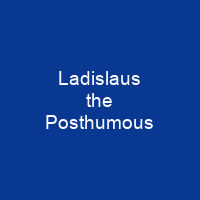Ladislaus V: The Posthumous King
Imagine a world where a child is born to rule but never gets the chance to see his own birth. This was the tragic story of Ladislaus V, also known as Ladislaus the Posthumous. Born in February 1440, he was destined for greatness from the moment his mother, Queen Elizabeth of Luxembourg, crowned him king at just a few months old. But what exactly does it mean to be ‘posthumous’? Is it more than just a fancy term? Let’s dive into this intriguing tale.
The Birth and Early Years
Albert II of Germany and his wife Elizabeth were expecting their child, but little did they know that Ladislaus would be born after Albert’s death. This unique situation set the stage for a complex political landscape in Central Europe. Queen Elizabeth, determined to secure her son’s future, crowned him king in 1440 despite the Hungarian Diet declaring his coronation invalid. The question remains: was this just a formality or did it truly matter?
The Struggle for Power
From the moment Ladislaus was born, he faced numerous challenges. His mother’s death in 1442 left him under the guardianship of Frederick III, King of the Romans. But as history shows, power struggles are never straightforward. The Hungarian Diet offered to acknowledge Ladislaus if Frederick renounced his guardianship, leading to a series of negotiations and compromises.
Bohemia and Beyond
In Bohemia, Ladislaus’ interests were represented by various individuals until John Hunyadi took control in 1452. His education under Frederick III was rigorous, focusing on Latin grammar and physical training to develop both mind and body. But as a young king, he faced significant opposition from powerful barons like George of Poděbrady.
The Ottoman Threat
One of the most critical moments in Ladislaus’ reign came when Sultan Mehmed II besieged Belgrade in 1456. John Hunyadi’s relief efforts were successful, but his death soon after left a void that would be filled by Matthias Hunyadi. Ladislaus returned to Hungary and appointed Ulrich of Celje as ‘captain general,’ only for him to be killed by Hunyadi’s soldiers in November 1456.
The Final Days
By March 1457, Ladislaus had imprisoned his brothers and sentenced them to death. His royal army was defeated, leading him to appoint John Jiskra as commander before leaving Hungary for Vienna with captive Matthias Hunyadi in June. Tragically, Ladislaus died unexpectedly on November 23, 1457, possibly from bubonic plague or leukemia.
His death marked the end of an era and set the stage for new rulers to take power. The House of Habsburg’s Albertinian Line came to an unexpected end with Ladislaus’ demise in Prague. His legacy remains a testament to the complexities of medieval European politics and the challenges faced by young kings.

So, what can we learn from Ladislaus V’s story? His life was a series of challenges and compromises, highlighting the intricate web of politics in medieval Europe. Despite his young age, he faced numerous obstacles and tried to assert his authority. But ultimately, it was his untimely death that brought an end to this fascinating chapter in history.
You want to know more about Ladislaus the Posthumous?
This page is based on the article Ladislaus the Posthumous published in Wikipedia (retrieved on November 27, 2024) and was automatically summarized using artificial intelligence.







